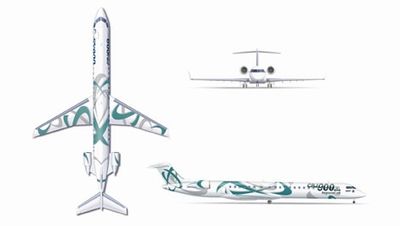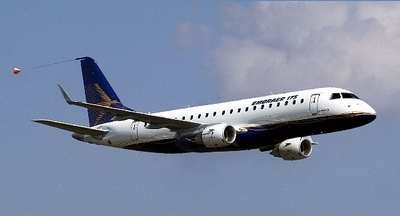Imagine Stretching Out On An RJ... But It'll Cost You
Now, here's an oxymoron: roomier, more luxurious regional jets.
In the wacky world of airline revenue, however, that idea isn't
just talk -- it's already happening. And it'll cost you.

As ANN has reported,
Northwest Airlines is already adding new 76-seat Bombardier CRJ900s
and Embraer 175s for its Mesaba and Compass subsidiaries,
respectively. Those planes include a dozen first-class seats
apiece, as well as purportedly more room for steerage -- er, coach
-- passengers.
Delta Air Lines also plans to fly 77 dual-class regional jets by
2008, including 14 new CRJ900s that will replace an equal amount of
50-seat CRJ100s in Comair's fleet. Subsidiaries and partners of
United Airlines already fly 115 70-seat RJs with first class,
Economy Plus, and coach seating.
It's no coincidence the three airlines pushing for larger
regional jets, are also three carriers most recently in bankruptcy.
Going through Chapter 11 allowed Northwest, United and Delta to
gain concessions from its pilots unions, to allow more of the
smaller jets.
The newer, spiffier planes aren't the airlines' way of atoning
for forcing passengers onto cramped 50-seat CRJs all these years.
Like everything else in the airline business, it's all about
money... and a way to charge premium fares throughout an airline's
mainline and regional operations.

As regional jets have become prevalent on more and more routes,
business-class passengers in particular have been asking for better
accomodations, Delta spokeswoman Betsy Talton told The Associated
Press. The aim with the new planes is "to make it all more seamless
and more like the mainline jet experience," she said.
The ability to charge premium fares on smaller planes also helps
airlines make money on routes that have been traditionally
loss-leaders. The AP cites as an example a Northwest flight from
Fargo to Minneapolis, which in the past has lost money on its own
(the airline makes up for it on flights out of its hub in MSP.)
Coach passengers pay $303 round-trip on the route; first class
fliers pay $981 -- for which they can enjoy hot meals, and close to
the same amount of room as in the first-class cabin of a larger
airliner.
Airlines believe enough passengers will be willing to pay for a
larger seat on an RJ, especially on longer flights, to make
regional jets profitable.
"What people really care about is nonstop service. And these
aircraft are the right size to introduce them into many markets
that wouldn't have it otherwise," said aviation consultant George
Hamlin of Airline Capital Associates.
There are bumps in the road for the plan. Although intended to
be more economical than traditional, larger planes, regional jets
don't actually save that much fuel on a per seat basis -- and, in
fact, often cost more, according to aviation consultant John F.
Walsh.
On a larger plane, fuel accounts for about one-quarter the
average cost-per-available-seat-mile; on an RJ, that figure climbs
to 40 percent of the CASM. More room for first class passengers
means fewer available seats on the plane, driving costs up even
further.

Also in question is increasing hostility towards regional jets
at larger airports, especially around New York City. As ANN reported, officials at
JFK, LaGuardia and Newark have asked the FAA to restrict airlines
from flying so many RJs into those airports, in the hopes airlines
will opt to fly fewer, larger planes -- each holding more
passengers than your typical RJ -- instead.
"We'd like to have more passengers on less planes," said Port
Authority of New York/New Jersey Aviation Director William DeCota
recently.
 NTSB Final Report: Cozy Cub
NTSB Final Report: Cozy Cub ANN FAQ: Contributing To Aero-TV
ANN FAQ: Contributing To Aero-TV Classic Aero-TV: Seated On The Edge Of Forever -- A PPC's Bird's Eye View
Classic Aero-TV: Seated On The Edge Of Forever -- A PPC's Bird's Eye View ANN's Daily Aero-Linx (04.29.25)
ANN's Daily Aero-Linx (04.29.25) ANN's Daily Aero-Term (04.29.25): Execute Missed Approach
ANN's Daily Aero-Term (04.29.25): Execute Missed Approach





